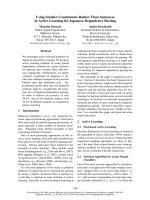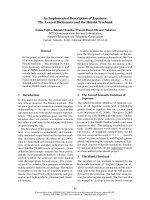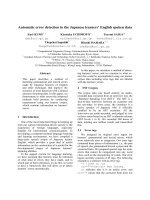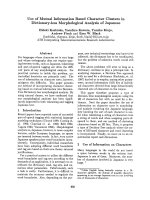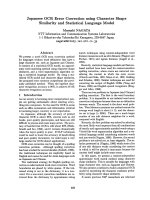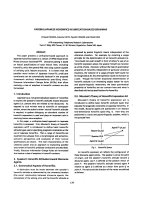Country briefing Japan
Bạn đang xem bản rút gọn của tài liệu. Xem và tải ngay bản đầy đủ của tài liệu tại đây (72.74 KB, 2 trang )
COUNTRY BRIEFING - JAPAN
A. FACTS AND STATISTICS
● Location: Eastern Asia, island chain between the North Pacific Ocean and the Sea of
Japan, east of the Korean Peninsula
● Capital: Tokyo
● Flag: The national flag of Japan has a red circle in the centre of a white rectangular field
and although it is officially called “ Nisshōki “, it is more commonly known as “ Hinomaru ”
which means ‘circle of the sun’ and reflects Japan’s designation as the ‘Land of the
Rising Sun’.
● National anthem: The Japanese national anthem is known as “ Kimigayo ”, meaning
‘The Emperor’s Reign’. It was adopted in 1888 and the words of the anthem were taken
from a poem which dates back to the 10th century when Japan was ruled by the
Emperor.
● Nationality: Japanese
● Ethnic: Japanese 98.5%, Koreans 0.5%, Chinese 0.4%, other 0.6% note: up to 230,000
Brazilians of Japanese origin migrated to Japan in the 1990s to work in industries; some
have returned to Brazil (2004)
● Population: 126.632.460 (January 2020 est.)
● Climate: The climate in Japan varies from tropical in the south to cool and temperate in
the north.
● Time Zone: The time zone in Japan is JST (Japan Standard Time) and is nine hours
ahead of UTC. There is currently no daylight-saving time in Japan.
● Currency: The currency in Japan is the Japanese Yen.
● Government: The government in Japan is constitutional monarchy. Although the
Emperor is the ceremonial head of state he has no constitutional powers.
● Internet penetration: 78.7% of the population (2019)
● Business Culture: Ranked 24th in The Business Culture Complexity Index™
● Economy: the world’s second largest developed economy, member of G7,the largest
electronics goods industry,the world’s third largest automobile manufacturing country
B. BEHAVIOUR DURING BUSINESS SOCIALISING, MEETINGS AND NEGOTIATION
●
●
Greeting:
- Wait to be introduced.It is considered impolite to introduce yourself, even in a large
gathering.
-"Last name" is used to introduce a rank instead of a first name.
- The bow is the form of greeting instead of shaking hands. How far you bow depends
upon your relationship to the other person as well as the situation. The deeper you bow,
the more respect you show.
Communication style:
- Frowning while someone is speaking is interpreted as a sign of disagreement.
- It is considered disrespectful to stare into another person's eyes, particularly those of a
person who is senior to you because of age or status.
-They never say no. If the request cannot be agreed to, they will say, 'it's inconvenient' or
'it's under consideration'.
- Business cards are given and received with two hands and a slight bow and give your
business card with the Japanese side facing the recipient.
●
●
- The Japanese often remain silent for long periods of time. Be patient and try to work out
if your Japanese colleagues have understood what was said.
- Gift-giving is highly ritualistic and meaningful and give items in odd numbers, but not 9
(the numbers 9 and 4 are considered unlucky in Japan).Gifts are not necessarily opened
upon receipt. Gift - giving is also a way to develop the good relationship.
What to wear:
- Men should wear a dark suit in the winter months with white shirt and tie that is not
brightly coloured.As the summer months can be very hot it is acceptable to wear half
sleeve shirts and light grey suits.
-Women should also dress conservatively, wear hair either short or tied back.
Conspicuous jewellery or short skirts are not considered appropriate.
- Take off your coat before entering a building
Meetings and negotiating:
- It is best to telephone for an appointment rather than send a letter, fax or email.
- Punctuality is important. Arrive on time for meetings and expect your Japanese
colleagues will do the same
- Materials should be handed to the participants of the meeting rather than the more
casual practice of ‘taking one and passing it on’.
- Always give a small gift, as a token of your esteem, and present it to the most senior
person at the end of the meeting.
-Never lose your temper or raise your voice during negotiations.
C. POSSIBLE BUSINESS OPPORTUNITIES
● Food and Beverage Business Opportunities
In Asia, Japan holds the second highest food consumption percentage at 23% next to
China which has 38% market share.The country’s self-sufficiency rate has declined to
39% across food groups making the industry a viable and profitable business opportunity.
Moreover, Japan has a population of about 127 million. It is one of the wealthiest and
most mature consumer markets in the world.They are highly interested in food with
superior taste and also interested in a wide variety of international food.
D. CHALLENGES
● Technical barriers such as quality assurance, food safety and hygiene, export procedures
and forms
● The goods distribution system in Japan is very complicated with many different levels
● The Japanese are also very fussy and careful in eating.
● Diverse traditional cuisine background
● Products from the competitors in the third country
● High labour force cost….
=> Some advice help reduce these challenges:
● Always control the quality of products
● Approach the goods distribution system from retail systems (supermarkets)
● Creating superior products but ensuring culture to be close to customers

